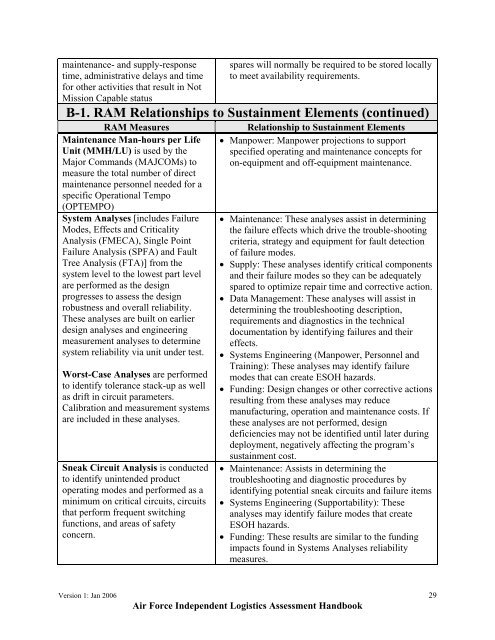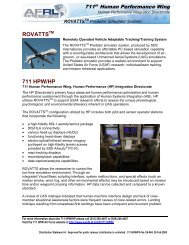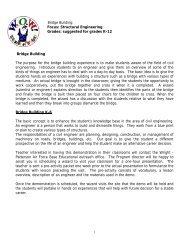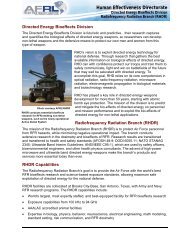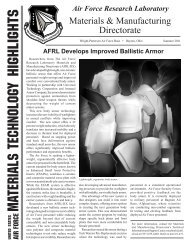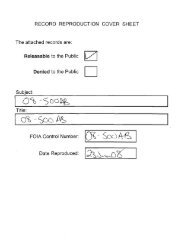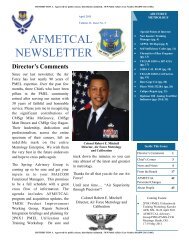USAF ILA Handbook - ACC Practice Center - Defense Acquisition ...
USAF ILA Handbook - ACC Practice Center - Defense Acquisition ...
USAF ILA Handbook - ACC Practice Center - Defense Acquisition ...
You also want an ePaper? Increase the reach of your titles
YUMPU automatically turns print PDFs into web optimized ePapers that Google loves.
maintenance- and supply-response<br />
time, administrative delays and time<br />
for other activities that result in Not<br />
Mission Capable status<br />
spares will normally be required to be stored locally<br />
to meet availability requirements.<br />
B-1. RAM Relationships to Sustainment Elements (continued)<br />
RAM Measures<br />
Maintenance Man-hours per Life<br />
Unit (MMH/LU) is used by the<br />
Major Commands (MAJCOMs) to<br />
measure the total number of direct<br />
maintenance personnel needed for a<br />
specific Operational Tempo<br />
(OPTEMPO)<br />
System Analyses [includes Failure<br />
Modes, Effects and Criticality<br />
Analysis (FMECA), Single Point<br />
Failure Analysis (SPFA) and Fault<br />
Tree Analysis (FTA)] from the<br />
system level to the lowest part level<br />
are performed as the design<br />
progresses to assess the design<br />
robustness and overall reliability.<br />
These analyses are built on earlier<br />
design analyses and engineering<br />
measurement analyses to determine<br />
system reliability via unit under test.<br />
Worst-Case Analyses are performed<br />
to identify tolerance stack-up as well<br />
as drift in circuit parameters.<br />
Calibration and measurement systems<br />
are included in these analyses.<br />
Sneak Circuit Analysis is conducted<br />
to identify unintended product<br />
operating modes and performed as a<br />
minimum on critical circuits, circuits<br />
that perform frequent switching<br />
functions, and areas of safety<br />
concern.<br />
Relationship to Sustainment Elements<br />
• Manpower: Manpower projections to support<br />
specified operating and maintenance concepts for<br />
on-equipment and off-equipment maintenance.<br />
• Maintenance: These analyses assist in determining<br />
the failure effects which drive the trouble-shooting<br />
criteria, strategy and equipment for fault detection<br />
of failure modes.<br />
• Supply: These analyses identify critical components<br />
and their failure modes so they can be adequately<br />
spared to optimize repair time and corrective action.<br />
• Data Management: These analyses will assist in<br />
determining the troubleshooting description,<br />
requirements and diagnostics in the technical<br />
documentation by identifying failures and their<br />
effects.<br />
• Systems Engineering (Manpower, Personnel and<br />
Training): These analyses may identify failure<br />
modes that can create ESOH hazards.<br />
• Funding: Design changes or other corrective actions<br />
resulting from these analyses may reduce<br />
manufacturing, operation and maintenance costs. If<br />
these analyses are not performed, design<br />
deficiencies may not be identified until later during<br />
deployment, negatively affecting the program’s<br />
sustainment cost.<br />
• Maintenance: Assists in determining the<br />
troubleshooting and diagnostic procedures by<br />
identifying potential sneak circuits and failure items<br />
• Systems Engineering (Supportability): These<br />
analyses may identify failure modes that create<br />
ESOH hazards.<br />
• Funding: These results are similar to the funding<br />
impacts found in Systems Analyses reliability<br />
measures.<br />
Version 1: Jan 2006 29<br />
Air Force Independent Logistics Assessment <strong>Handbook</strong>


